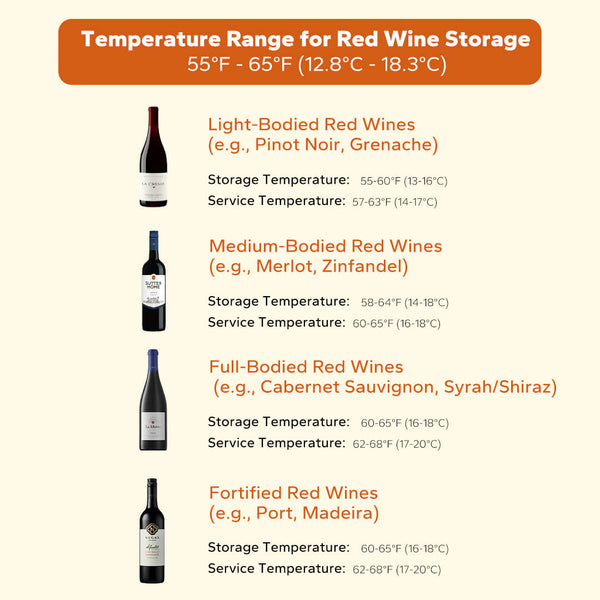To keep the quality and taste of red wine, it is very important to keep the temperature just right. Temperature has a big effect on how red wine smells, tastes, and is structured. Fruitiness and acidity tend to stay the same at cooler temperatures, while secondary notes can come out more clearly and tannins can become softer at warmer temperatures. To get the most out of the wine, you need to find the right balance.
Ideal Temp For Storing and Serving Red Wine
The recommended temperature range for storing red wine typically falls between 55°F (12.8°C) and 65°F (18.3°C). Within this range, wines can age well and show off all of their subtleties. temps below 55°F (12.8°C) may slow down aging, while temps above 65°F (18.3°C) can speed it up, which could cause oxidation and flavor loss before they should.

Light-Bodied Red Wines (e.g. Pinot Noir, Grenache)
Storage Temperature: 55-60°F (13-16°C)
Service Temperature: 57-63°F (14-17°C)
A little cooler temperatures help lighter red wines keep their delicate flavors and smells. To let the wine's smells shine through, serve it at a slightly higher temperature than when it was stored.
Medium-Bodied Red Wines (e.g. Merlot, Zinfandel)
Storage Temperature: 58-64°F (14-18°C)
Service Temperature: 60-65°F (16-18°C)
Red wines with a medium body need slightly warmer storage temperatures to make their structure and richness better. To bring out the fruitiness and balance the tannins, serve the wine a little chilled.
Full-Bodied Red Wines (e.g. Cabernet Sauvignon, Syrah/Shiraz)
Storage Temperature: 60-65°F (16-18°C)
Service Temperature: 62-68°F (17-20°C)
Warmer storage temperatures help soften the tannins in full-bodied red wines so that their tastes get better over time. A temperature just below room temperature will bring out the depth and richness of the wine when you serve it.
Fortified Red Wines (e.g. Port, Madeira)
Storage Temperature: 60-65°F (16-18°C)
Service Temperature: 62-68°F (17-20°C)
Fortified red wines, which are sweeter and have more alcohol, should be kept and given at the same temperature as full-bodied red wines. Putting fortified wines in the fridge for a short time before serving can help balance out their sweetness and alcohol heat.
How to Set Your Wine Fridge Temp
It's important to keep your wine fridge at the right temperature to keep the quality of your red wines, whether you're keeping them for a short time or a long time. Here's a more detailed guide on how to adjust your wine fridge temperature for different types of red wines and storage durations.

Single-Zone Wine Fridges
Short-Term Storage: Aim for a temperature between 55-60°F (13-16°C). This range is suitable for most red wines and allows you to enjoy them at a moment's notice without compromising their quality.
Long-Term Storage: If you plan to store your red wines for an extended period, opt for a slightly cooler temperature range of 55-58°F (13-14°C). Cooler temperatures help slow down the aging process and preserve the wine's flavors and aromas over time.
Dual-Zone Wine Fridges
Red Wine Zone: Set the temperature between 55-65°F (13-18°C), depending on the types of red wines you plan to store. Keep it cooler for lighter-bodied reds and slightly warmer for fuller-bodied varieties.
White Wine Zone: Maintain a temperature range of 45-55°F (7-13°C) for white wines, ensuring they stay crisp and refreshing.
Tips for Setting and Maintaining Wine Fridge Temperature
Invest in a Quality Wine Fridge
Choose a wine cooler specifically designed for storing wine, with features such as adjustable temperature controls, humidity levels, and vibration reduction.
Find the Ideal Location
Place your wine fridge in a cool, dark, and well-ventilated area away from direct sunlight, heat sources, and temperature fluctuations.
Set the Right Temperature
Refer to the recommended temperature range for red wines and adjust your wine fridge settings accordingly. Use a digital thermometer to monitor internal temperatures regularly and make adjustments as needed to maintain consistency.
Avoid Frequent Temperature Changes
Consistency is key when it comes to storing red wine. Fluctuations in temperature can disrupt the aging process and compromise wine quality. Rapid temperature changes can cause expansion and contraction of the liquid inside the bottle, leading to seepage or leakage of the cork and exposing the wine to oxygen. Minimize opening the wine fridge unnecessarily and refrain from making drastic temperature adjustments, as this can stress the wine and affect its flavor profile.
Organize Wine Bottles Properly
Lay wine bottles out flat on racks to protect the corks from dry air and keep them wet. Leave room between the bottles so that air can flow properly and to avoid crowding, which can cause the temperature to change.
Regular Maintenance
Clean your wine fridge regularly to remove dust, debris, and potential mold growth. Check the door seals for tightness and ensure they are properly sealed to maintain temperature stability.
Factors Affecting Red Wine Temperature
Wine Variety: Different types of red wine have different tastes and structures that change in different ways when the temperature changes. For full-bodied wines like Cabernet Sauvignon and Malbec, serving them a little warmer makes them taste more complex. On the other hand, for lighter-bodied wines like Pinot Noir and Beaujolais, serving them a little cooler keeps their delicate smells.
Tannin Content: Natural chemicals called tannins are found in grape skins, seeds, and stems. They give red wines their astringency and structure. Wines with more tannins usually need to be served a little warmer so that the tannins don't stick to the palate as much and the full range of tastes can come through. Serving wines with strong tannins, like Bordeaux blends or Barolo made with Nebbiolo, at the cooler end of the temperature range can help ease their sourness.
Acidity: Another important thing that affects how hot or cold you think red wine is is its acidity. Chianti and Barbera, which are both made from Sangiovese, can handle slightly cooler serving temperatures without losing their freshness and energy. Cooler temperatures bring out the acidity in the wine, which balances out the fruitiness and makes it easier to drink overall.
Age and Maturity: The best temperature to serve red wine depends on how old and fully developed it is. It is best to serve younger, fruitier wines at cooler temperatures so that their main aromas and tastes stand out. On the other hand, wines that have been aged in bottles for a long time usually need slightly warmer temperatures to bring out their tertiary smells and smooth out any rough edges that are still there. Older wines, like Bordeaux or Burgundy that has been stored, may taste better when served closer to room temperature.









